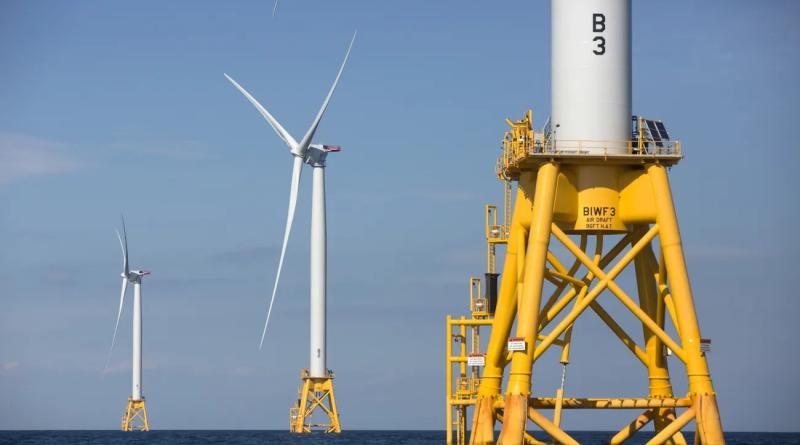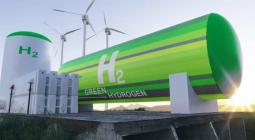How ocean wind power could help the US fossil fuel industry

The government wants to lease offshore wind in the Gulf of Mexico – but the oil industry wants it for its own needs
Offshore wind farms in the Gulf of Mexico proposed by the Biden administration could generate enough electricity for 3.1m homes in Texas and Louisiana. But industry is eyeing the potential for offshore wind farms to instead power oil refining, steel and fertilizer manufacturing and other industrial processes.
The administration has committed to building 30 gigawatts of offshore wind to power 10m homes nationally by 2030 to help boost renewable energy in the country. But multiple companies interested in leasing offshore parcels in the Gulf of Mexico want to use that energy to make renewable hydrogen to power industrial processes to reduce their carbon footprint. The so-called “green” hydrogen could be sent to shore via the gulf’s existing extensive oil and gas pipeline network and replace traditional hydrogen made from fossil fuels. Green hydrogen could reduce the state’s carbon emissions by as much as 68% and spark an industrial revolution, according to proponents.
The approach, yet to be tested anywhere in the world, is being criticized by some as inefficient and a way to prolong the life of the region’s oil and gas industry even as the International Energy Agency has called for a halt to the development and production of oil and gas to keep climate pollution at manageable levels.
“Hydrogen is, at worst, a false solution and, at best, potentially a distraction,” said Kendall Dix, national policy director for Taproot Earth, a grassroots activist organization concerned with climate pollution. “If you want to have an energy system that is truly climate and people-friendly, we need to focus on building out renewable energy and using that to help people.”
Lower carbon business
After leasing offshore tracts for offshore wind off the Atlantic coast, the federal government, through the Bureau of Ocean Energy Management (BOEM), is now turning to the Gulf of Mexico as part of President Joe Biden’s plan to create enough wind power for 10m homes by 2030. BOEM plans to issue leases in two areas of the Gulf of Mexico for wind next summer: one about 91 miles off Lake Charles, Louisiana, and a second 29 miles off the coast of Galveston, Texas.
In response to the government request for feedback, about 10 companies expressed interest in establishing offshore wind farms in the Gulf of Mexico. Shell New Energies is among them, saying in an eight-page letter submitted to BOEM that it wants to build a “lower carbon power business” by producing green hydrogen. Utility Entergy also has expressed interest in building out wind farms to create traditional renewable electricity. Shell did not respond to multiple requests for an interview.
Hydrogen, which is produced using water and power, can, among other things, be used to power vehicles, produce electricity when mixed with natural gas and fuel industrial processes, including at oil refineries and plastics plants.
It’s that last industrial application that’s most attractive in Louisiana, as 70% of the state’s greenhouse gas emissions comes from the industrial sector. The state is the nation’s largest per capita user of industrial hydrogen. Hydrogen burns significantly hotter than natural gas but produces no carbon dioxide. Currently, hydrogen is almost exclusively created using natural gas, methane or coal.
Allison DeJong, a planner with the Water Institute of the Gulf, says green hydrogen, which does not have a carbon footprint, could be a viable solution for the fossil fuel industry to decarbonize. Green hydrogen has the potential to reduce the state’s carbon emissions by as much as 68%, according to the International Energy Agency.
Developers are also interested in making hydrogen in the Gulf of Mexico because, with modifications, the gulf’s extensive network of existing natural gas and hydrogen pipelines could be used to ship the hydrogen to shore. Such a move would make the cost of producing hydrogen less expensive. Without the use of existing pipelines, a study by the National Renewable Energy Laboratory says development of offshore hydrogen would be cost-prohibitive because new pipelines would have to be built.
Louisiana state representative Joseph Orgeron, a maritime specialist, says the vast majority of developers he’s talked to are proposing mixing hydrogen with natural gas to ship it to shore. “It could be injected in the existing natural gas pipelines along with other natural gas coming to shore and then extracted on the other end,” said Orgeron. Orgeron sponsored legislation requiring the state’s public service commission to study the costs and best ways of achieving an offshore wind pilot project in the gulf by 2026.
But some, including the Sierra Club, say using green hydrogen in industrial processes is simply another form of greenwashing and should not be used to justify the build-out of the fossil fuel industry. “We should not support projects that label themselves as ‘sustainable’ because their fuel source includes a small fraction of hydrogen when the lion’s share of it is fracked gas,” according to an analyst at Sierra.
Additionally, the World Economic Forum points out that using offshore wind to produce green hydrogen is less efficient than funneling that electricity directly into the power grid. Between 20% to 40% of the wind energy gets lost in the process to convert it into green hydrogen. “If you have a turbine producing electricity, the cheapest and best use of that electricity is going to be using it directly for things electricity is already used for as opposed to converting it to hydrogen,” said Warren Leon, executive director for Clean Energy States Alliance.
The push for hydrogen
Talks about offshore wind and hydrogen aren’t just happening along the Gulf coast. Similar discussions are taking place on the Atlantic coast and in Europe, though no offshore wind-to-hydrogen projects have yet been completed.
Leon said Europe’s offshore wind production may soon exceed demand for electricity. Europe’s offshore wind capacity is approximately 14,600 megawatts, and is set to increase by as much as 25 times that by 2030.
Louisiana’s grid currently has just 4% renewable energy, and no onshore or offshore wind farms. The state’s climate taskforce’s climate action plan calls for 5,000 megawatts of offshore wind on the grid by 2035.

The National Renewable Energy Laboratory says the gulf could potentially generate nearly 510,000 megawatts of offshore wind energy annually, twice the current energy needs of the five states (Louisiana, Texas, Mississippi, Alabama and Florida) that make up the Gulf coast region.
David Dismukes, executive director and a professor at the Center for Energy Studies, Louisiana State University, says because of the way electricity markets are structured in the state, offshore wind to generate electricity will be a tough sell for investors. “It’s not cost competitive,” he said in a recent Gulf Coast Energy Outlook webinar.
Entergy, Louisiana’s largest utility, has indicated interest in offshore wind. In September, it signed a memorandum of understanding with Diamond Offshore Wind to explore the possibility. The company has plans to cease the use of coal by the end of 2030 and to build at least 11,000 megawatts of renewable energy to replace the coal.
An industrial revolution
Despite the obstacles, opposition and costs, development of offshore hydrogen has significant support.
Earlier this year, the Greater New Orleans Development Foundation received approximately $50m (£41m) in federal money to research and develop a green hydrogen hub. That plan hinges on the development of offshore wind to create green hydrogen. Governor John Bel Edwards supports the creation of an offshore wind-powered hydrogen energy industry, and the state is supporting the foundation’s hydrogen efforts, called H2theFuture, with an additional $25m (£21m).
“Demand for green hydrogen is expected to grow 500% by 2050 and south Louisiana’s unmatched demand is the most efficient place to supply this need,” according H2theFuture. The development of an offshore wind-based hydrogen economy could result in 34,500 new jobs by 2030, according to the initiative.
“If indeed the primary focus is to develop offshore wind in the service of green hydrogen, then there is potentially good to be had there,” said Logan Burke, executive director of the Alliance for Affordable Energy, a consumer advocacy group in Louisiana. “[But] it doesn’t matter how clean it is if the way you use it is not clean.”
This story is also published in the Louisiana Illuminator and The Lens.
cover photo: The first offshore wind farm in the US began operations in late 2016 off Block Island in Rhode Island. Photograph: Michael Dwyer/AP






